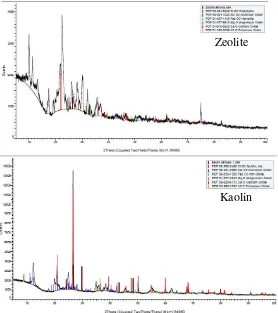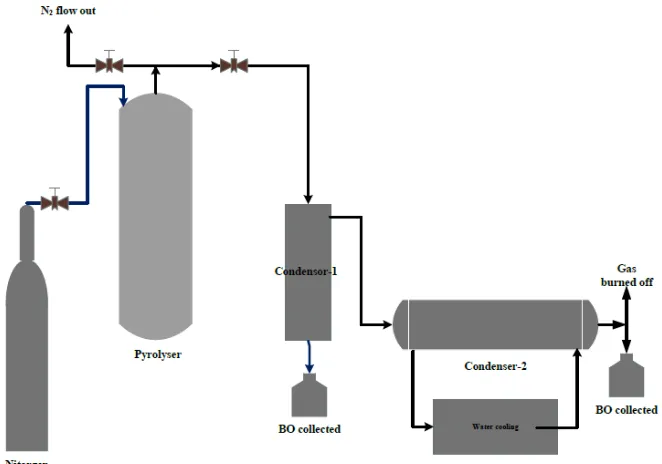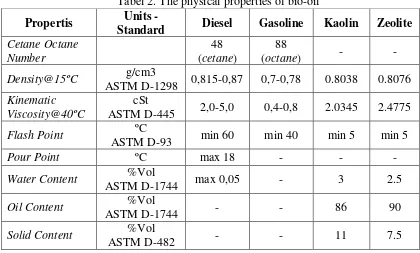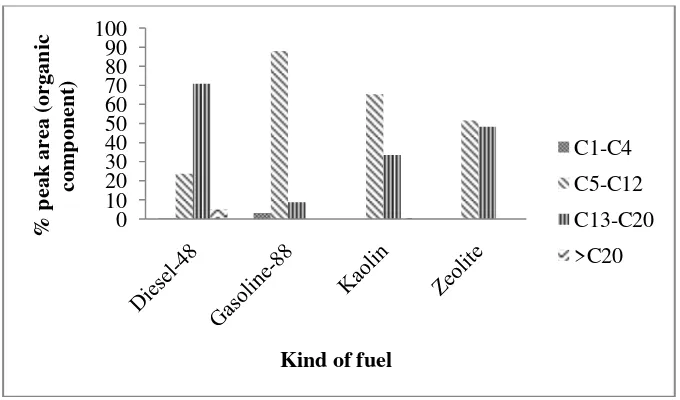A Comparison of Activated Natural Zeolite and
Kaolin as a Catalyst in the Isothermal-Catalytic
Cracking of Real MSW to Produce Bio-Oil
Indra Mamad Gandidi1, M. Dyan Susila1, and Heri Rustamaji2
1
Department of Mechanical Engineering, Faculty of Engineering, Universitas of Lampung, Jl. S. Brojonegoro, Bandarlampung 35145, Indonesia
2
Department of Chemical Engineering, Faculty of Engineering, Universitas of Lampung, Jl. S. Brojonegoro, Bandarlampung 35145, Indonesia.
Carresponding Author: [email protected]
Abstract
In this work, the real MSW converted into bio-oil have been investigated by pyrolysis method. The pyrolysis experimental was carried out in the isothermal fixed bed reactor at temperature 400 °C with reaction time 60 minutes. The natural activated zeolite and kaolin catalyst were employed in this process with catalyst-MSW ratio 0.5 w/w and influence of activated catalyst to pyrolysis productivity and bio-oil properties were studied. A comparison result between zeolite and kaoline catalytic pyrolysis was examined and bio-oil product was analyzed by GC-MS method which it can be used to identify carbon number range by percentage of peak areas. From this study, yields of liquid fuel or bio-oil were found around 23.6 and 21.4 for kaolin and zeolite catalytic pyrolysis respectively. The carbon range distribution in bio-oil was
65.38% peak area of gasoline range (C5-C12) and 33.49% peak area of
diesel range (C13-C20) for activated kaolin catalytic cracking. For
activated zeolite has 51.62% peak area of gasoline range (C5-C12) and
48.37% peak area of diesel range (C13-C20). Based on GCMS result, both
of bio-oil products were mostly contains of paraffin and olefin. Regarding to the carbon range, the use of kaolin as catalyst was better than the zeolite to convert the real MSW into bio-oil.
Keywords: MSW, natural catalyst, pyrolytic bio-oil
1. Introduction
The open dumping system of municipal solid waste (MSW) in many developing country like Indonesia has created a lot of impacts to the people and environment in which this is no longer relevant regarding to the limitations in the urban area [1], a habitat for insects, pests and bacteria that can spread various diseases in the open environment and the piles of garbage in the landfill will produce some leachate that contaminates the ground and surface water [2]. Furthermore, it will be degraded biochemically and produce methane gas into the atmosphere where it is known that the potential of methane gas pollution is about twenty times more dangerous than the pollution by CO2 [3]. In addition, many
cities around the world have agreed that MSW is one of major contributors for flood and increased of global warming and greenhouse gas effect as well [4].
The calorific value content is around 20.57 MJ / kg [7] and thus, MSW is one of the potential energy material that can be converted into bio-energy. Several methods for bio-energy production from MSW have been proposed and one of them is pyrolysis method. The pyrolysis method is a thermal degradation in which MSW is converted into solid fraction, liquid fraction consisting of paraffins, olefins, naphthenes and aromatics and gas at elevated temperature in absence the oxygen [8] and usually, the temperature is used in range 400-600 oC.This process is intended to break down the long hydrocarbon chain into short-chain hydrocarbon. Hence, the use of municipal solid waste has appeared eligibility to develop as a raw material for bio-oil production by pyrolysis technique [9-12] and MSW converted into bio-oil have attracted much attention of many people due to easily in stored, transported and upgraded.
Recently, some researchers have focused on using of catalysts to reduce the activation energy on the pyrolysis process and to improve thermal efficiency due to endothermic reaction at high temperature and the decomposition process improvement during catalytic cracking as well. The presence of catalyst will generate the secondary cracking to the solid and liquid. Thus, the higher pyrolytic product can be desired. Chika M, et al. [13] was carried out the catalytic pyrolysis by using Y-zeolit and ZSM-5 as catalyst to convert electric and electronic plastic waste into bio-oil, Aida, et al. [14] by using fluidized catalytic cracking (FCC) catalyst to convert plastic waste, Norbert M, et al. [15] was perform catalytic pyrolysis by Y-Zeolite, FCC, MoO3 and HZSM-5 to convert MSW and MPW,
Almeida D and Marque MDF. [16] was perform the comparison study between thermal and HZSM-5-catalytic cracking to the municipal plastic waste, Funda A, et al. [17] was studied of catalyst efficiency (Y-zeolite, β-zeolite, equilibrium FCC, MoO3, Ni–Mo-catalyst, HZSM-5) on the catalytic cracking of MSW and
MPW. Anyhow, all of researchers above have used synthetic or commercial catalysts in the pyrolysis process in which it will take the high costs of production caused faster deactivation time of catalyst by MSW impurities or contaminant and it is unfavorable effort in the viewpoint of economic issues.
Furthermore, the selection of appropriate natural catalyst for real MSW pyrolysed has been required and so far kaolin and zeolite has not been used as catalyst in the pyrolysis process of real MSW.
Therefore, this research was focused to investigate the productivity and selectivity behavior of natural zeolite and kaolin as a catalyst on pyrolysis process to produce bio-oil from the real MSW in which it is a mixture of some kinds of biomass waste, several plastics waste, textile waste, papers waste and rubber waste. The pyrolysis bio-oil that obtained was analyzed to study the characteristics of bio-oil included the products composition and yield, chemical and physical properties of bio-oil. Afterward, a comparison result between pyrolysis and conventional oil (diesel-48 and gasoline-88) was performed to examine a possibility to substitute the conventional fuels
2. Material and Methods
a. Waste and catalyst for pyrolysis
The MSW that was applied in this experiment collected from the final disposal site located on Bakung district, Bandarlampung city. This MSW consist of some kind of waste, i.e. vegetable waste from the traditional market, garden waste, household waste, LDPE, HDPE, paper/cardboard, PS, rubber waste and textile waste. All of the samples were dried around 3-5 days by the sun then separated to account the composition of each component. The dry MSW was then chopped into smaller pieces than 5-10 cm to provide the proportional size with reactor capacity. The composition (dry basis) and physical form of MSW is shown in Fig. 1.
Fig.1. The composition and physical of MSW used in this experiment
The natural zeolite and kaolin that used in this study was obtained from the local source in Lampung province, Indonesia and then grinded by hummer mill and sieved by 20-30 mesh. Afterward, zeolite and kaolin were activated thermally of 500 oC for 2 hour to improve the active site and crystallinity behavior of catalyst. To examine the structure and surface of natural zeolite and kaolin, the XRD method was employed and the composition and X-ray patterns of the activated natural zeolite and kaolin was shown in Tables 1 . It could be seen that the hight amount of SiO2 and Al2O3 compound contented in natural zeolite and
kaolin has shown that zeolite and kaolin were very likely to used as a catalyst in the pyrolysis process. These compounds could increase the cracking efficiency and increase the pyrolytic product. Among of them, activated zeolite has seen preferably than the kaolin to decomposition process of real MSW.
34%
52%
9% 3% 2% Biomass
Plastics
Paper
Rubber
Tabel 1. X-Ray analysis for chemical composition of activated zeolite and kaolin
Kind of Catalyst Unit Compound Concentration
Zeolite
% SiO2 68.5
% Al2O3 13.17
% Fe2O3 2.98
% MgO 1.15
% CaO 2.47
% K2O 1.80
% Na2O 1.06
% TiO2 0.14
Kaolin
% SiO2 43.12
% Al2O3 46.07
% Fe2O3 0
% MgO 0.27
% CaO 0.3
% K2O 0.01
% ZnO 0.0064
% TiO2 0.74
Source: CV. Mina Tama, Bandarlampung
Figure 2. is showing the X-pattern for both of catalyst. The peak sharply was showed by both pattern in which it is implies that natural zeolite and kaolin have a good crystallinity behavior and possibly to give a strong effect in the decomposition of MSW and stable at high temperatures.
Fig. 2. X-Ray patterns of the activated zeolite and kaolin Zeolite
b. Pyrolysis Experiment and Bio-oil Analysis
The MSW sample was pyrolysed in a laboratory scale using fixed bed vacuum reactor that equipped with air lock valve between reactor and hopper to avoid the air takes the place of entry into the reactor. The reactor is made from the stainless cylinder with the dimension of 310 mm in height, 160 mm in ID and the electrical heating jacket that connected by thermo controlled and thermocouple was taped around the reactor. The reactor was set vertically that connected by nitrogen tube with the rubber tube and then N2 gas was introduced into the reactor for 3 minutes
from the top and flow out passed through the top of the reactor. The flow of nitrogen replaces the air from the reactor and permits the pyrolysis reaction under inert vacuum condition.
In the experiment procedure, firstly nitrogen gas was introduce into the reactor and then the reactor was heated until reactor temperature reaches the set value of 400 oC with 12 oC heating rate and followed by feeding around 750 g of mixed catalyst-MSW were fed into reactor by opened air lock valve. The ratio of catalyst to MWS was 250:500 g. Set the time reaction was 60 minutes for both of pyrolysis experiment. The gas produced from the pyrolysis was flow out from the top of rector and it flow into vacuum gas cleaner as a first condenser then the gas went to shell and tube condensers at 20 °C as a secondary condenser to separate process between permanent gas and liquid. Condensation product from the vacuum cleaner and condenser are mixture of bio-oil and water, then this mixture separated by precipitation and filtration process. The gaseous products were burned off to prevent emission from hydrocarbon gases. The char produced was remained in the reactor and collected after the pyrolysis reaction was finished. The installation of experimental apparatus is shown in the Fig. 3.
Fig. 3. The installation of experiment apparatus
gasoline range (C5-C12), diesel (C12-C20), heavy oil (> C20) that consist of paraffin,
olefins, naphthenes and aromatics [23]. In order to examine the bio-oil, pyrolysis liquid was analyzed by using a gas chromatography mass spectrometry (GC-MS, QP2010S Shimadzu) which it can be used to identify carbon number range and chemical composition by percentage of peak areas. The column was DB-1 (Agilent J 100% dimethyl polysiloxane) capillary column, 30 m length with 0.25
mm diameter and 25 μm film thickness. Helium was used as the gas carrier. The
temperature was set in initial temperature 60°C for 5 min followed by a heating rate of 5 °C/min to 280 °C and held for 51 min. To estimation the heating value of bio-oil, it was approached with the carbon-hydrogen weigh ratio [24] in which it has been explained that the paraffin has highest heating value and then followed by iso-paraffin, olefin, nepthenes and aromatic (PIONA). Also, the distributions of PIONA in the each range of hydrocarbon were calculated to determine the selectivity behavior of natural zeolite and kaolin catalysts in the pyrolysis process.
3. Results and Discussion
a. Physical Properties of Bio-oil
Table 2. is showing the physical properties of bio-oil such as density and viscosity for conventional fuel and bio-oil which it were analyzed based on ASTM methods. It can be seen that the both of bio-oil from the natural catalytic cracking have similar in the density value and significantly different on the viscosity property. The kinematic viscosity of natural kaolin was lower than the natural zeolite. It is indicated that the natural kaolin has good cracking reaction compared the natural zeolite. However, both of bio-oil has properties close to diesel-48 and acceptable to be considered as a future energy. Due to solid and water content in the bio-oil, both of bio-oil have solid and water content highly regarding to impurities in the unwashed real MSW and direct catalytic as well. The very high of solid content in the bio-oil was also be affected by ash from the biomass material.
Tabel 2. The physical properties of bio-oil
Propertis Units -
b. Products Yield and Chemical Properties of Bio-oil
The product from the real MSW pyrolysed was shown in Figure 4. Catalytic cracking to real MSW was produced pyrolysis bio-oil around 23.6 and 21.4% by use natural kaolin and zeolite respectively. The natural kaolin has a higher yield compared the natural zeolite. This yield was indicated that natural kaolin has productivity behavior better than the natural zeolite in the pyrolysis process. This behavior can be explained due to its active site and acidity, which facilitate the cracking reaction in the pyrolysis. However, the highest yield on the gaseous product and appearance of water content in the bio-oil was imply that the further drying for real MSW was required and temperature of condensation environment around 20 oC was unfavorable. Moreover, the quite low on bio-oil yield can also be associated to the time reaction shortly and long residence time of gas in the reactor [25]. The similar result was also presented by Panda, KA. [26] that use of kaolin as a catalyst in plastic waste pyrolysed.
Fig 4. Mass yield of pyrolytic products
Figure 5. is presenting the carbon distribution range in the conventional and pyrolytic oil. The pyrolytic oil from real MSW pyrolysed is mostly contain of gasoline (C5-C12) and then followed by diesel (C13-C20) and small amount of
heavy oil (C>20).
Bio-oil by natural kaolin catalytic was consisting of 65.38% peak area of gasoline fraction and 33.49% peak area of diesel fraction. While bio-oil by natural zeolite has 51.62% peak area of gasoline fraction and 48.37% peak area of diesel fraction. Clearly, natural kaolin has shown better properties as a catalyst for the production of bio-oil from municipal solid waste compared with natural zeolite although natural zeolite has not heavy oil fraction in the bio-oil. The microstructure and pore size of the natural catalyst can be used as a reason to this distinction.
Fig 6. A comparison of mass species between bio-oil and conventional fuel
Hereinafter, figure 6. is reveal the organic component in the bio-oil in which most of organic component in the bio-oil is paraffin and olefin with small amount of aromatic, alcohol and acid. There is only slight difference in the amount of paraffin and olefin between natural kaolin and natural zeolite in catalytic cracking process. Consequently, bio-oil from natural kaolin and natural zeolite catalytic pyrolysis have the same caloric value and it was illustrates that both of natural catalyst at 400 oC and 60 minutes have similarities in the selectivity behavior.
Figure 7. is describing the PIONA contents in the each hydrocarbon range on the pyrolytic bio-oil in which shows that gasoline fraction was contain more olefin than the paraffin and otherwise with the diesel fraction for both of pyrolytic bio-oil. This composition was significantly affected by kind of real MSW especially plastics and biomass in which as a determinant of chemical reaction during the process of pyrolysis. The presence of impurities and natural catalyst in the real MSW was also allegedly playing an important role to the bio-oil composition [27]
4. Conclusion
The real MSW is the great potential raw material that can be converted into hydrocarbon range as a paraffin and olefin by thermal-catalytic cracking. By use activated natural catalyst (kaolin and zeolite) can increase the product of bio-oil (productivity behavior) but quite low in the selectivity behavior. Among of them, kaolin catalyst has demonstrated a better capability for pyrolysis process. The upgrading process to enhance the pyrolysis oil yield is necessary to obtain a bio-oil with gasoline range and more. Currently, the influence of time reaction, temperature and particle size of catalyst are investigating. Also double stage pyrolysis is studied.
Reference
[1]. Arinal H., et al. (2010) ‘Integrated system for Municipal Solid Waste Management in Bandarlampung City as an environmental conservation and energy production’, Final report of strategic research grant, University of Lampung
[2]. Alexandra, LC. (2012) ‘Municipal Solid Waste: turning a problem into resource - Waste: the challenges facing developing countries’, Urban Specialist, France, pp. 2-4
[3]. Haradhan, M. (2012) ‘Dangerous effects of methane gas in atmosphere’, International Journal of Economic and Political Integration, Vol. 2, No. 1, pp. 3-10
[4]. Hari, BD., et al. (2013) ‘Greenhouse gas emission reduction options for cities: Finding the Coincidence of Agendas between local priorities and climate change mitigation objectives’, Habitat International, V. 38, pp. 100-105
[5]. Ebru, A., et al. (2009) ‘Energy Content Estimation of Municipal Solid Waste by Multiple Regression Analysis’, 5th International Advanced Technologies Symposium, Karabuk, Turkey.
[6]. McKendry, P. (2002) ‘Energy production from biomass (part 1): overview of biomass’, Bioresource Technology, V. 83, P. 37–46
[7]. Ari, DP., et al. (2007) ‘Feasibility study of MSW power plant in Bandung’, Final Report, Research Institution on ITB
[8]. Hossain, AK and Davies, P.A. (2013) ‘Pyrolysis liquids and gases as alternative fuels in internal combustion engines: A review. Renewable and Sustainable Energy Reviews. V. 21. pp. 165–189
[9]. Liu, YQ., et al. (2012) ‘Characterization of pyrolysis oil from municipal solid waste’, CRETE, 3RD International Conference on Industrial and Hazardous Waste Management
[11]. Velghe, I., et al. (2011) ‘Study of the pyrolysis of municipal solid waste for the production of valuable products’, Journal of Analytical and Applied Pyrolysis, V. 92, pp. 366–375
[12]. Ayhan, D. (2004) ‘Pyrolysis of municipal plastic wastes for recovery of gasoline-range hydrocarbon’, J. Anal. Appl. Pyrolysis, V. 72, pp. 97–102
[13]. Chika, M., et al. (2015) ‘Catalytic Pyrolysis of Waste Plastic from Electrical and Electronic Equipment’, Energy Research Institute, Faculty of Engineering, University of Leeds, Leeds, LS2 9JT, UK
[14]. Aida Isma, M. I., et al. (2015) ‘Mixed Plastic Wastes Pyrolysis in a Fluidized Bed Reactor for Potential Diesel Production’, International Journal of Environmental Science and Development, Vol. 6, No. 8, pp. 606-609
[15]. Norbert, M., et al. (2013) ‘Comparison of waste (MSW and MPW) pyrolysis in batch reactor over different catalysts. Part II: Contaminants, char and pyrolysis oil properties’, Bioresource Technology, V. 144, pp. 370–379
[16]. Almeida, D and Marque, MDF. (2015) ‘Thermal and catalytic pyrolysis of
plastic waste’, Instituto de Macromoléculas Eloisa Mano, Universidade Federal
do Rio de Janeiro – UFRJ, Rio de Janeiro, RJ, Brasil, http://dx.doi.org/10.1590/0104-1428.2100
[17]. Funda, A., et al. (2013) ‘Comparision of waste (MSW and MPW) pyrolysis in batch reactor over different catalysts. Part I: Product yields, gas and pyrolysis oil properties’, Bioresource Technology, V. 133, pp. 443–454
[18]. Wenger, J. (2015) ‘Catalytic Pyrolysis of Waste Plastics’, Journal of Materials Science and Engineering, V. 5, No. 3-4, pp. 183-185
[19]. Kyaw, K T., et al. (2015) ‘Effect of various catalysits on fuel oil pyrolysis process of mixed plastic wastes’, International Journal of Advances in Engineering & Technology, V. 8, No. 5, pp. 794-802
[20]. Panda, KA and Singh, RK. (2013) ‘Experimental Optimization of Process for the Thermo-catalytic Degradation of Waste Polypropylene to Liquid Fuel’, Advances in Energy Engineering (AEE), V. 1, pp. 74-84
[21]. Mochamad, S., et al. (2014) ‘Fuel Oil Production from Municipal Plastic Wastes in Sequential Pyrolysis and Catalytic Reforming Reactors’, Energy Procedia, V. 47, pp. 180 – 188
[22]. Wang, JL., et al. (2011) ‘Catalytic Pyrolysis of Municipal Plastic Waste to Fuel with Nickel-loaded Silica-alumina Catalysts’, Energy Sources, Part A: Recovery, Utilization, and Environmental Effects, V. 33, No. 21, pp. 1940-1948 [23]. J. Aguado., et al. (2007) ‘Feedstock recycling of polyethylene in a two-step thermo-catalytic reaction system’, J. Anal. Appl. Pyrolysis, V. 79, pp. 415-423. [24]. Riazi, MR. (2005) ‘Characterization and properties of petroleum’, First edition,
Kuwait University
[25]. Ayhan, D., et al. (2009) ‘Pyrolysis Mechanisms of Biomass Materials’, Energy Sources, Part A, V. 31, pp. 186–119
[26]. Panda, KA. (2014) ‘Thermo-catalytic degradation of low density polyethylene to liquid fuel over kaolin catalyst’, Int. J. Environment and Waste Management, Vol. 13, No. 1, pp. 104-114




